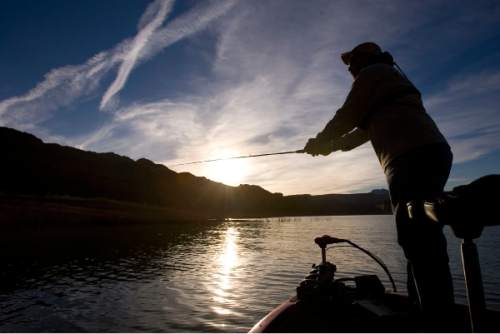This is an archived article that was published on sltrib.com in 2016, and information in the article may be outdated. It is provided only for personal research purposes and may not be reprinted.
Taxpayers can expect to foot up to 72 percent of the controversial Lake Powell Pipeline's costs, according to University of Utah economists who analyzed repayment models developed in support of the billion-dollar-plus proposal to pipe Colorado River water 140 miles to St. George.
The analysis by scholars Gabriel Lozada and Gail Blattenberger concluded that the financial consultant for the Washington County Water Conservancy District underestimates the project's costs, fails to consider interest on state bonds that would be issued, and ignores operating and maintenance costs.
Without a generous state subsidy in form of interest-free loans, the water delivered by the pipeline "is so expensive that Washington County would not want the water and in that case the pipeline would not be needed," Blattenberger told the Utah Water Development Commission Tuesday.
The district's funding model, which includes a rate hike of 28 cents per 1,000 gallons, can cover only 28 percent of construction, interest and operations costs, according to her findings, which were endorsed by 17 U. economics faculty members in a recent letter to Gov. Gary Herbert and legislative leaders.
These conclusions contradict water officials' claims that the pipeline could pay for itself with modest increases in water rates and impact fees levied on future development. Pipeline critics cited the findings to renew their call on state officials to abandon the project, which proponents say is needed to sustain growth in Utah's arid southwest corner.
Utah Rivers Council contends St. George, which uses more water per capita than almost any other U.S. city, could meet its needs through conservation and conversion of agriculture water to municipal use. Such measures would avoid tapping the already stressed Colorado River system and saddling its citizens — or the rest of Utah — with excessive debt, said Zach Frankel, the group's executive director.
"No one would ever ask a bank for a loan while intending to repay just 28 percent of the debt, unless they're a scam artist. Yet that's exactly what water lobbyists convinced the Legislature to do," he told the water commission, which did not directly address the economists' pipeline critique at its Tuesday meeting.
Water district officials received the report Tuesday and were not prepared to give a detailed response, but they reiterated promises the district will repay all costs as required under the Lake Powell Pipeline Development Act — the 2006 law authorizing state financial participation in the project.
While the cost estimates for the project range from under $1 billion to $2.8 billion, the final price tag has yet to be pinned down. It will depend on the pipeline's alignment, the extent of its hydropower features and final design, according to district spokeswoman Karry Rathje.
Much of this will be determined following years of federally mandated environmental reviews, and accordingly will be outside the district's control. Officials from the Federal Energy Regulatory Commission (FERC) began a two-day site visit in southern Utah Tuesday, examining the proposed route.
The U. economists used the $1.3 billion to $1.7 billion cost estimate submitted to FERC by the water district.
But Rathje said the repayment model cited by the U. economists is really an "interactive exercise" that the district's Las Vegas-based consultant Jeremy Aguero held with constituents.
"It was a focus group exercise that is now being confused with a financing model," she added. "The decision to build the pipeline hasn't been made yet. We get caught up in the details when we need to take a step back and see this is preliminary research into whether this is the best project for Utah."
Critics contend the district long ago decided to build a pipeline and have hired Aguero to promote it, not objectively gather information. Aguero is a lawyer, not a trained economist, whose undergraduate degree is in hotel administration. The district has paid Aguero's firm, Applied Analysis, $418,000 over the past few years, according to invoices obtained by Utah Rivers Council.
The new analysis is at least the third Lozada and Blattenberger have conducted into the pipeline's financing. They have previously concluded that the water district would have to raise impact fees by 120 percent to $14,000 per unit; raise water rates by 570 percent to meet its financial obligations; and hike property tax rates to the maximum allowed under state law. That's based on a $1.3 billion project cost with 4 percent interest over 50 years.
In response to that critique, the water district had claimed Aguero's models demonstrated that the project could be built without such steep rate hikes, yet declined to release them to the public. Frankel obtained the district's analysis in June after a protracted public records battle.
The U. economists scrutinized Aguero's work and said they found holes and questionable assumptions. For example, they note the repayment models assume water price has no relationship with consumption, in defiance of a basic economic principle known as the Law of Demand.
The economists predict water use will plummet once residents feel the sting of rate hikes, and the district would collect far less from water rates than it projects.
Behind the pipeline fight is Washington County's meteoric growth and perceptions that it is running out of water. Retirees and families are drawn to Utah's Dixie by its balmy winters, year-round golf, safe communities and redrock vistas.
According to projections from the Governor's Office of Planning and Budget, the region's population is expected to more than triple to 600,000 by 2060. The water district contends the 86,000 acre feet of water the pipeline would deliver is necessary to feed this growth.
"If they grow as aggressively as they claim, they are going to pave all their farmlands," Frankel said. "If they pave farmlands they should transfer the water rights. There are 125,000 acre feet of ag water, yet the district projects it can get only 10,000. It clearly shows they are ignoring cheaper water in favor in collecting billings from taxpayers and dumping it into the coffers of construction companies."
—
Brian Maffly covers public lands for The Salt Lake Tribune. Maffly can be reached at bmaffly@sltrib.com or 801-257-8713. Twitter: @brianmaffly —
Economic analysis presented
University of Utah economics professor Gabriel Lozada will discuss a new analysis of financing for the proposed Lake Powell Pipeline at noon Wednesday in the Moot Courtroom of the S.J. Quinney College of Law. The public is invited.







